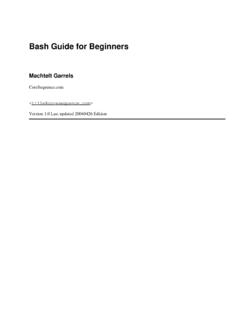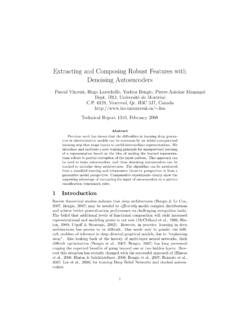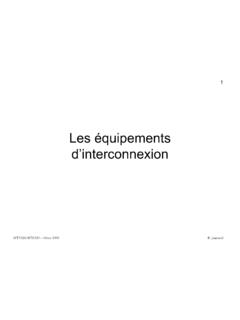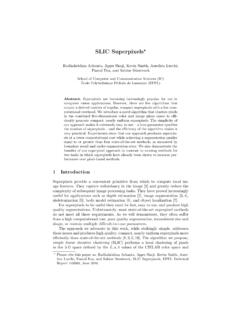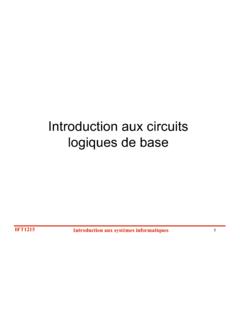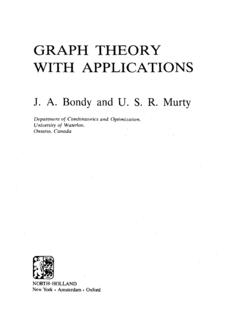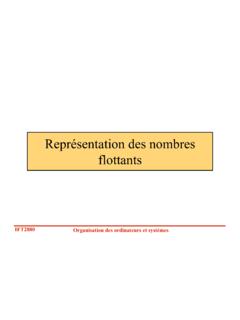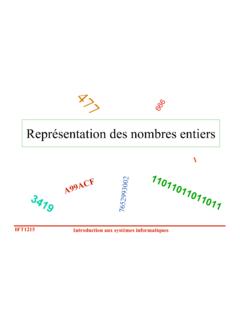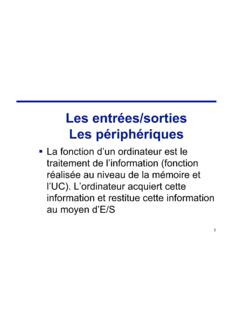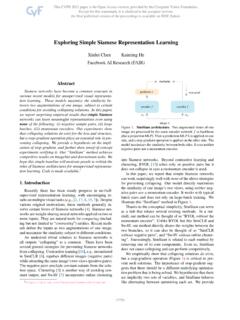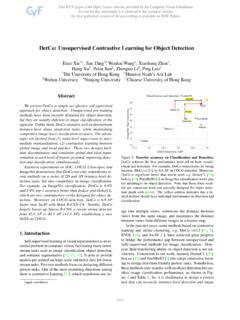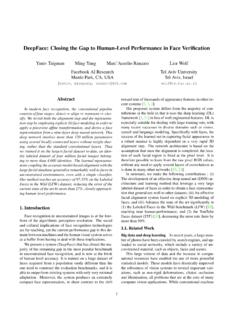Transcription of Learning Deep Architectures for AI - Université de Montréal
1 1 Learning Deep Architectures for AIYoshua BengioDept. IRO, Universit e de Montr 6128, Montreal, Qc, H3C 3J7, bengioyTechnical Report 1312 AbstractTheoretical results strongly suggest that in order to learnthe kind of complicated functions that can repre-sent high-level abstractions ( in vision, language, and other AI-level tasks), one needsdeep architec-tures. Deep Architectures are composed of multiple levels of non-linear operations, such as in neural netswith many hidden layers or in complicated propositional formulae re-using many sub-formulae. Searchingthe parameter space of deep Architectures is a difficult optimization task, but Learning algorithms such asthose for Deep Belief Networks have recently been proposed to tackle this problem with notable success,beating the state-of-the-art in certain areas.
2 This paper discusses the motivations and principles regardinglearning algorithms for deep Architectures , in particularthose exploiting as building blocks unsupervisedlearning of single-layer models such as Restricted Boltzmann Machines, used to construct deeper modelssuch as Deep Belief computers to model our world well enough to exhibitwhat we call intelligence has been the focusof more than half a century of research. To achieve this, it isclear that a large quantity of informationabout our world should somehow be stored, explicitly or implicitly, in the computer. Because it seemsdaunting to formalize manually all that information in a form that computers can use to answer questionsand generalize to new contexts, many researchers have turned tolearning algorithmsto capture a largefraction of that information.
3 Much progress has been made tounderstand and improve Learning algorithms,but the challenge of artificial intelligence (AI) remains. Do we have algorithms that can understand scenesand describe them in natural language? Not really, except invery limited settings. Do we have algorithmsthat can infer enough semantic concepts to be able to interact with most humans using these concepts? we consider image understanding, one of the best specifiedof the AI tasks, we realize that we do not yethave Learning algorithms that can discover the many visual and semantic concepts that would seem to benecessary to interpret most images. The situation is similar for other AI assume that the computational machinery necessary to express complex behaviors (which one mightlabel intelligent ) requires highly varying mathematical functions, mathematical functions that arehighly non-linear in terms of raw sensory inputs.
4 Consider for example the task of interpreting an inputimage such as the one in Figure 1. When humans try to solve a particular task in AI (such as machine visionor natural language processing), they often exploit their intuition about how to decompose the probleminto sub-problems and multiple levels of representation. Aplausible and common way to extract usefulinformation from a natural image involves transforming theraw pixel representation into gradually moreabstract representations, , starting from the presence of edges, the detection of more complex but localshapes, up to the identification of abstract categories associated with sub-objects and objects which are partsof the image, and putting all these together to capture enough understanding of the scene to answer questionsabout it.
5 We view the raw input to the Learning system as a highdimensional entity, made of many observedvariables, which are related by unknown intricate statistical relationships. For example, using knowledgeof the 3D geometry of solid object and lighting, we can relatesmall variations in underlying physical andgeometric factors (such as position, orientation, lighting of an object) with changes in pixel intensities forall the pixels in an image. In this case, our knowledge of the physical factors involved allows one to get apicture of the mathematical form of these dependencies, andof the shape of the set of images associatedwith the same 3D object. If a machine captured the factors that explain the statistical variations in the data,and how they interact to generate the kind of data we observe,we would be able to say that the machineunderstandsthose aspects of the world covered by these factors of variation.
6 Unfortunately, in general andfor most factors of variation underlying natural images, wedo not have an analytical understanding of thesefactors of variation. We do not have enough formalized priorknowledge about the world to explain theobserved variety of images, even for such an apparently simple abstraction asMAN, illustrated in Figure high-level abstraction such asMANhas the property that it corresponds to a very large set of possibleimages, which might be very different from each other from the point of view of simple Euclidean distancein the space of pixel intensities. The set of images for whichthat label could be appropriate forms a highlyconvoluted region in pixel space that is not even necessarily a connected region.
7 TheMANcategory can beseen as a high-level abstraction with respect to the space ofimages. What we call abstraction here can be acategory (such as theMANcategory) or afeature, a function of sensory data, which can be discrete ( , theinput sentence is at the past tense) or continuous ( , theinput video shows an object moving at a particularvelocity). Many lower level and intermediate level concepts (which we also call abstractions here) would beuseful to construct aMAN-detector. Lower level abstractions are more directly tiedto particular percepts,whereas higher level ones are what we call more abstract because their connection to actual percepts ismore remote, and through other, intermediate level do not know exactly how to build robustMANdetectors or even intermediate abstractions that wouldbe appropriate.
8 Furthermore, the number of visual and semantic categories (such asMAN) that we wouldlike an intelligent machine to capture is large. The focusof deep architecture Learning is to automaticallydiscover such abstractions, from the lowest level featuresto the highest level concepts. Ideally, we would likelearning algorithms that enable this discovery with as little human effort as possible, , without having tomanually define all necessary abstractions or having to provide a huge set of relevant hand-labeled these algorithms could tap into the huge resource of text and images on the web, it would certainly help totransfer much of human knowledge into machine-interpretable of the important points we argue in the first part of this paper is that the functions learned should have astructure composed of multiple levels.
9 Analogous to the multiple levels of abstraction that humans naturallyenvision when they describe an aspect of their world. The arguments rest both on intuition and on theoreticalresults about the representational limitations of functions defined with an insufficient number of levels. Sincemost current work in machine Learning is based on shallow Architectures , these results suggest investigatinglearning algorithms for deep Architectures , which is the subject of the second part of this much of machine vision systems, Learning algorithms havebeen limited to specific parts of such a pro-cessing chain. The rest of of design remains labor-intensive, which might limit the scale of such the other hand, a hallmark of what we would consider intelligent includes a large enough vocabulary ofconcepts.
10 RecognizingMANis not enough. We need algorithms that can tackle a very largeset of suchtasks and concepts. It seems daunting to manually define thatmany tasks, and Learning becomes essentialin this context. It would seem foolish not to exploit the underlying commonalities between these these tasksand between the concepts they require. This has been the focus of research onmulti-task Learning (Caruana,1993; Baxter, 1995; Intrator & Edelman, 1996; Baxter, 1997). Architectures with multiple levels natu-rally provide such sharing and re-use of components: the low-level visual features (like edge detectors) andintermediate-level visual features (like object parts) that are useful to detectMANare also useful for a largegroup of other visual tasks.
